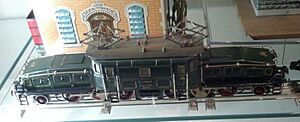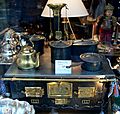Märklin facts for kids
 |
|

Märklin Museum in Göppingen
|
|
| Private | |
| Founded | 1859 |
| Headquarters | , |
|
Key people
|
Theodor Friedrich Wilhelm Märklin (founder), Caroline Märklin, Eugen Märklin, Karl Märklin |
| Products | Toys, model railway products |
| Parent | Simba Dickie Group |
Märklin is a famous German toy company. It started way back in 1859 in Göppingen, Germany. While Märklin first made accessories for doll houses, it is now best known for its amazing model railways and other cool technical toys. In some parts of Germany and Sweden, the name Märklin is almost like saying "model trains"!
Contents
Märklin's Story

Märklin was started by Theodor Friedrich Wilhelm Märklin in 1859. When he passed away in 1866, his wife, Caroline Märklin, bravely took over the business. She led the company until 1888.
Later, Eugen Märklin and Karl Märklin took charge. In 1891, Märklin released its first wind-up train. It came with carriages that ran on special tracks. The company realized that train sets, like dollhouses, could be expanded over time. This meant people would buy more tracks and trains to add to their collection for years!

Märklin helped create many popular sizes, or "gauges," for model railways. In 1891, Märklin set standards for toy trains, called gauges 1-5. They showed these at the Leipzig Toy Fair, and these sizes quickly became international standards. Märklin then introduced other popular sizes like O gauge, HO scale in 1935, and the super tiny Z scale (1:220) in 1972. Z scale was the smallest in the world for many decades!
Today, Märklin still makes trains and accessories in Gauge 1, HO scale, and Z scale. In 1994, Märklin bought another model train company called Trix. Märklin's older trains are very popular with collectors and can be quite valuable.
Besides trains, Märklin also made other toys. From 1914 to 1999, they produced building sets, similar to Meccano. They also made slot car systems, toy cars, boats, and even model steam engines that ran on alcohol. These steam engines were great for learning and could even power small lights!
In 2009, Märklin faced some financial challenges. However, they worked hard and announced they were making a profit again in 2010. In 2013, Märklin became part of the Simba Dickie Group, a large toy company.
During the 2020-2021 COVID pandemic, many people spent more time at home. This led to a big increase in Märklin's sales! They even had to hire new employees to keep up with the demand for their trains and parts.
The Märklin Train System
The Märklin system is a special way model trains get power. Instead of two rails, it uses a "third rail" hidden in the track. Small metal studs stick up through the ties (the wooden parts) of the track. The two outer rails are connected electrically. This makes wiring simpler, especially for tricky track layouts like reverse loops. It also looks more realistic because you only see two rails.
Märklin's system is a bit different from other HO scale trains. Märklin train wheels are not insulated, so if you use them on other companies' tracks, they might cause a short circuit. Also, for many years, Märklin was the only brand that used AC (alternating current) for its HO trains. Most other companies used DC (direct current). However, some companies started making trains that could run on the Märklin AC system. Märklin also started offering DC locomotives under the Trix brand after buying Trix.
Märklin Digital Control
Märklin was one of the first model train companies to introduce a digital control system. This system, called Märklin Digital, came out in 1984. It uses special computer chips to control trains. This means you can control multiple trains on the same track independently! You can also control lights, sounds, and other features on your trains.
Märklin's digital system for its 3-rail tracks is not directly compatible with another popular digital system called DCC (Digital Command Control). However, Märklin now offers DCC-compatible locomotives for its 2-rail DC Trix brand.
Products and Collectibles
Over the years, Märklin models have become very valuable to collectors. Some very old models can sell for high prices at auctions! Märklin makes a huge variety of products, and collectors even pay attention to the original packaging. Collectors also look for rare models, like the famous SBB Crocodile locomotive or the Union Pacific Big Boy model.
Märklin often includes a special print number on its boxes and other printed materials. This number tells you when and where the item was printed, which helps collectors figure out how old a model is.
Märklin mainly makes German (DB) model trains. But they also produce trains from Switzerland (SBB), the Netherlands (NS), and even American trains from the "Golden Age" of railroads.
In 2005, the Märklin museum in Göppingen, Germany, was robbed. Over 100 valuable items, including unique prototypes, were stolen. Luckily, they were all found and returned in March 2005!
In 2006, a popular board game called Ticket to Ride released a special version named Märklin to honor the company.
HO Scale Trains
The biggest part of Märklin's products and sales is the HO scale. This scale is 1:87, meaning the model is 87 times smaller than the real thing. Märklin introduced HO scale in 1935. Today, it's the most common model train size around the world. Märklin is the market leader for HO scale trains in German-speaking countries, with about half of the market share.
In the HO scale, there are two main types of track systems. One uses two conductors (like most other brands), and the other is Märklin's middle-conductor system. Märklin is the only company that offers a complete range of products for its HO system. This includes many different trains, tracks, and both analog (older style) and digital control systems.
Images for kids
-
Stationary steam engine, 1930
See also
 In Spanish: Märklin para niños
In Spanish: Märklin para niños










